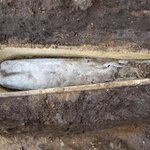Archaeology

Would you drink wine flavored with mint, honey and a dash of psychotropic resins? Ancient Canaanites did more than 3,000 years ago.
Archaeologists have unearthed what may be the oldest, and largest,ancient wine cellar in the Near East, containing forty jars, each of which held up to fifty liters of strong, sweet wine flavored with mint, honey and a dash of psychotropic resins. The cellar was discovered in the ruined palace of a sprawling Canaanite city in northern Israel, called Tel Kabri, far from many of Israel's modern-day wineries, and dates to about 1,700 B.C.
The jar…

An unusually large find, more 600 stamp seals and cylinder seals, have been found so far in an ancient sanctuary
of the storm and weather god Jupiter Dolichenus
in Turkey.
The stamp seals and cylinder seals as well as scarabs, made of glass, stone and quartz ceramics, were mostly crafted in a high-quality manner. Following the restoration work, the finds were handed over to the relevant museum in Gaziantep in Turkey.
Such large amounts of seal consecrations are unheard-of in any comparable sanctuary, said excavation director Prof. Dr. Engelbert Winter and archaeologist Dr. Michael…

An archaeological dig on Jerusalem's Mount Zion has revealed the well-preserved lower levels of what the archaeological team believes is an Early Roman period mansion from the first century AD, possibly belonging to a member of the Jewish priestly caste, which may yield significant domestic details about the rulers of Jerusalem at the time of Jesus.
Particularly important in the discoveries were a buried vaulted chamber that has proven to be an unusual finished bathroom (with bathtub) adjacent to a large below-ground ritual cleansing pool (mikveh) -- only the fourth bathroom to be found in…
The circular stone enclosures known as the temple at Göbekli Tepe in southeastern Turkey remain the oldest of its kind, dating back to around the 10th millennium B.C.
But
Göbekli Tepe
may also be the world's oldest science building.
Giulio
Magli of the Polytechnic University of Milan hypothesizes it may have been built due to the “birth” of a “new” star; the brightest star and fourth brightest object of the sky, what we call Sirius (Greek for "glowing").
Sirius, which we also call the 'dog star' due to its location in the constellation Canis Major, was obviously not born 12,000…

A mass grave in an artificial cave in the historical Maya city of Uxu has uncovered the skeletons of 24 people in an approximately 32 square meter artificial cave that had formerly been used as a water reservoir.
"Aside from the large number of interred individuals, it already became apparent during the excavation that the skeletons were no longer in their original anatomical articulation," says archaeologist Nicolaus Seefeld from the University of Bonn.
Translation:They were decapitated and dismembered around 1,400 years ago.
All of the skulls were lying scattered around the…

New findings from an archaeological excavation prove that copper mines in Israel thought to have been built by the ancient Egyptians in the 13th century BC actually originated three centuries later, during the reign of the legendary King Solomon, according to the dig lead.
Based on the radiocarbon dating of material unearthed at a new site in Timna Valley in Israel's Aravah Desert, the findings overturn the archaeological consensus of the last several decades. Scholarly work and materials found in the area suggest the mines were operated by the Edomites, a semi-nomadic tribal confederation…
9 ancient Egyptian iron beads which were carefully hammered into thin sheets before being rolled into tubes over 5,000 years ago were actually hammered from pieces of meteorites and not iron ore.
The objects trace their origins to outer space and predate the emergence of iron smelting by two millennia.
The beads were originally strung into a necklace together with other exotic minerals such as gold and gemstones, revealing the high value of this exotic material in ancient times, say the scholars in the Journal of Archaeological Science.
Excavated in 1911, in a pre-dynastic cemetery near…

Researchers have unearthed the remains of massive ancient fortifications built around an Iron-Age Assyrian harbor in the contemporary Israeli coastal city of Ashdod, just south of Tel Aviv.
At the heart of the well-preserved fortifications is a mud-brick wall up to more than 12 feet wide and 15 feet high. The wall is covered in layers of mud and sand that stretch for hundreds of feet on either side. When they were built in the eighth century B.C., the fortifications formed a daunting crescent-shaped defense for an inland area covering more than 17 acres.
Dr. Alexander Fantalkin of Tel Aviv…
For as much as the War of the Roses has been over-analyzed and documented, you'd think researchers would know where the Battle of Bosworth, which brought the Plantagenet King of England Richard III to a grisly end at the hands of the Tudors, was fought.
Not really. it was thought that the Battle of Bosworth took place at a site in Leicestershire called Ambion Hill. There is a battlefield heritage center there. Like Glastonbury being the burial place of King Arthur, sometimes the English just pick a spot.
But in 2005 the Leicester City Council brought in Dr. Glenn Foard to try and…

University of Leicester archeologists lifted the lid of a medieval stone coffin near the final resting place of Richard III this week - and found a mysterious coffin-within-a-coffin.
This is their second dig at the Grey Friars site, where the medieval king, one of the most infamous in English history, was discovered in September, and the first fully intact stone coffin to be discovered in controlled excavations. It is believed to contain one of the friary's founders, or a medieval monk. Within the stone coffin, they found an inner lead coffin – and will need to carry out further analysis…